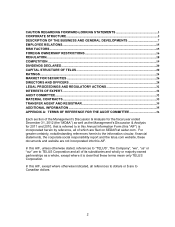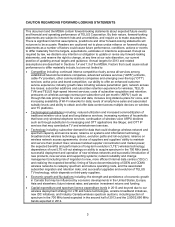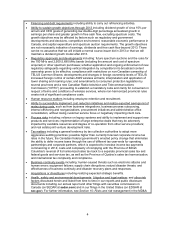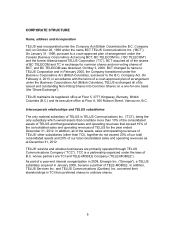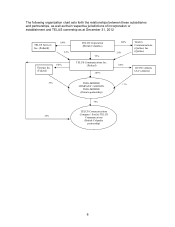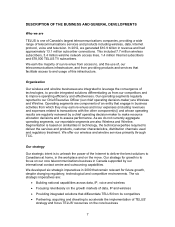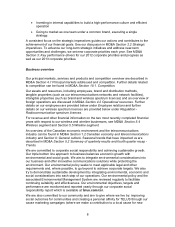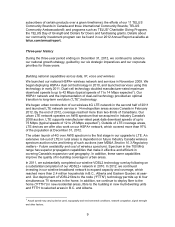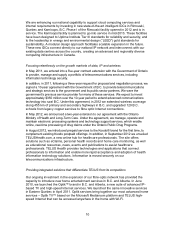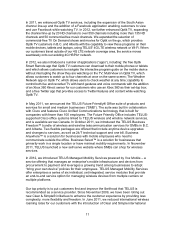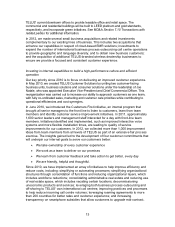Telus 2012 Annual Report Download - page 3
Download and view the complete annual report
Please find page 3 of the 2012 Telus annual report below. You can navigate through the pages in the report by either clicking on the pages listed below, or by using the keyword search tool below to find specific information within the annual report.
3
CAUTION REGARDING FORWARD-LOOKING STATEMENTS
This document and the MD&A contain forward-looking statements about expected future events
and financial and operating performance of TELUS Corporation. By their nature, forward-looking
statements are subject to inherent risks and uncertainties, and require us to make assumptions.
There is significant risk that assumptions, predictions and other forward-looking statements will
not prove to be accurate. Readers are cautioned not to place undue reliance on forward-looking
statements as a number of factors could cause future performance, conditions, actions or events
to differ materially from the targets, expectations, estimates or intentions expressed. Except as
required by law, we disclaim any intention or obligation to update or revise any forward-looking
statements, and reserve the right to change, at any time at our sole discretion, our current
practice of updating annual targets and guidance. Annual targets for 2013 and related
assumptions are described in Sections 1.4 and 1.5 of the MD&A. Factors that could cause actual
performance to differ materially include, but are not limited to:
• Competition including: continued intense competitive rivalry across all services among
established telecommunications companies, advanced wireless services (“AWS”) entrants,
cable-TV providers, other communications companies and emerging over-the-top (“OTT”)
services; active price and brand competition; our ability to offer an enhanced customer
service experience; industry growth rates including wireless penetration gain; network access
line losses; subscriber additions and subscriber retention experience for wireless, TELUS
TV® and TELUS high-speed Internet services; costs of subscriber acquisition and retention;
pressures on wireless average revenue per subscriber unit per month (“ARPU”) such as
through flat-rate pricing trends for voice and data, inclusive long distance plans for voice, and
increasing availability of Wi-Fi networks for data; levels of smartphone sales and associated
subsidy levels; and ability to obtain and offer data content across multiple devices on wireless
and TV platforms.
• Technological substitution including: reduced utilization and increased commoditization of
traditional wireline voice local and long distance services; increasing numbers of households
that have only wireless telephone services; continuation of wireless voice ARPU declines
such as through substitution to messaging and OTT applications like Skype; and OTT IP
services that may cannibalize TV and entertainment services.
• Technology including: subscriber demand for data that could challenge wireless network and
spectrum capacity and service levels; reliance on systems and information technology;
broadband and wireless technology options, evolution paths and roll-out plans; reliance on
wireless network access agreements; choice of suppliers and suppliers’ ability to maintain
and service their product lines; wireless handset supplier concentration and market power;
the expected benefits and performance of long-term evolution (“LTE”) wireless technology;
dependence of rural LTE roll-out strategy on ability to acquire spectrum in the 700 MHz band;
successful deployment and operation of new wireless networks and successful introduction of
new products, new services and supporting systems; network reliability and change
management (including risk of migration to new, more efficient Internet data centres (“IDCs”)
and realizing the expected benefits); timing of future decommissioning of iDEN and CDMA
wireless networks to redeploy spectrum and reduce operating costs, and the associated
subscriber migration and retention risks; and successful upgrades and evolution of TELUS
TV technology, which depends on third-party suppliers.
• Economic growth and fluctuations including: the strength and persistence of economic growth
in Canada that may be influenced by economic developments in the United States, Europe,
Asia and elsewhere; future interest rates; and pension investment returns and funding.
• Capital expenditure and spectrum licence expenditure levels in 2013 and beyond due to our
wireless deployment strategy for LTE and future technologies, wireline broadband initiatives,
new IDC initiatives, and Industry Canada wireless spectrum auctions, including auction of
spectrum in the 700 MHz band expected in the second half of 2013 and the 2,500/2,690 MHz
bands expected in 2014.


